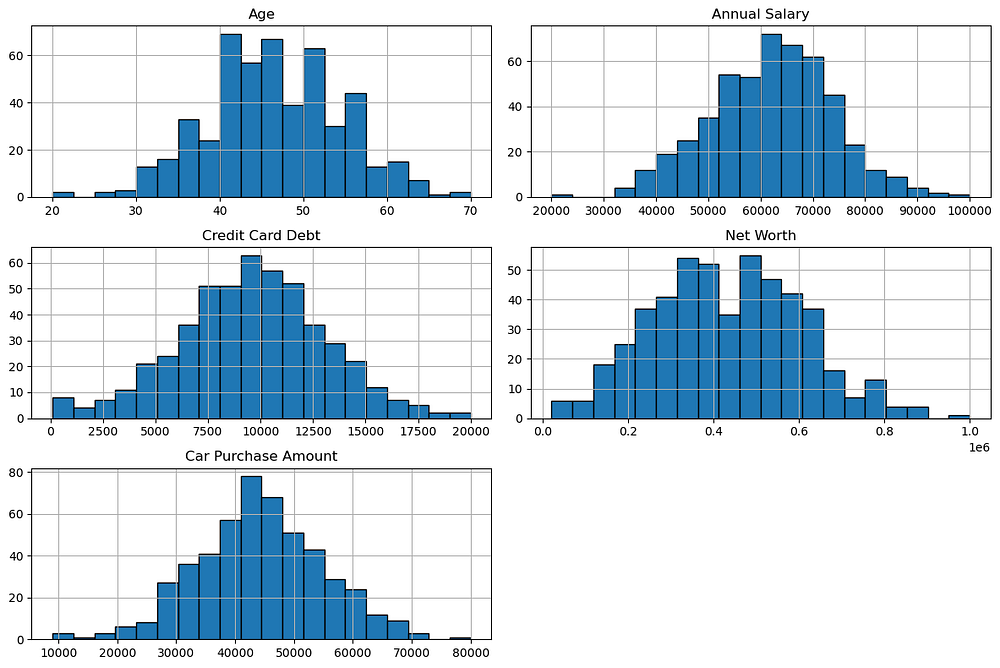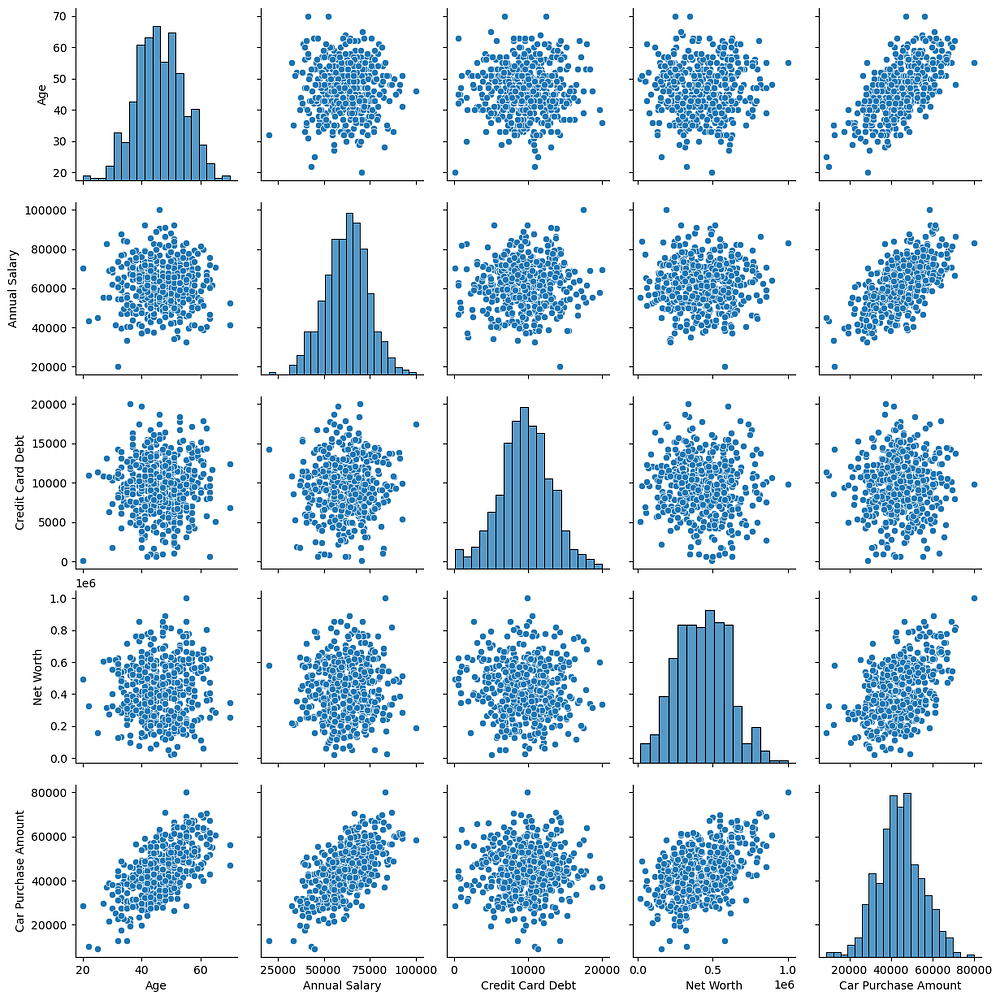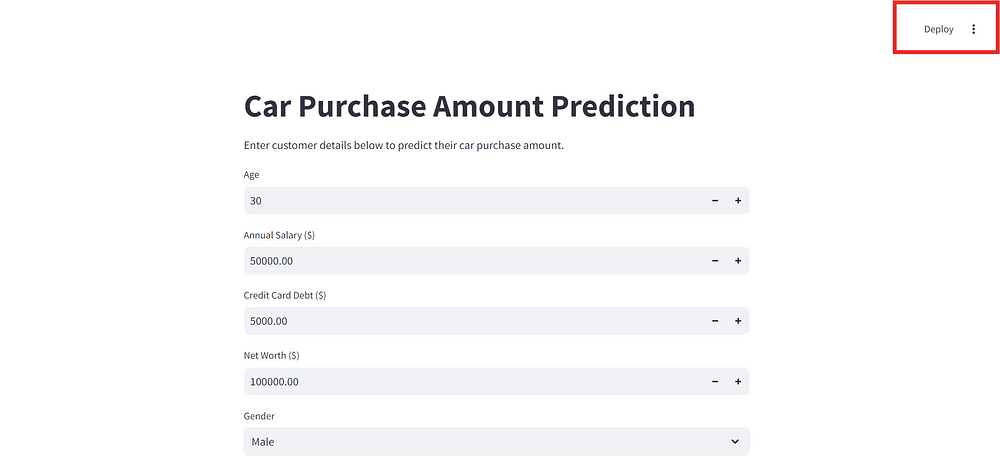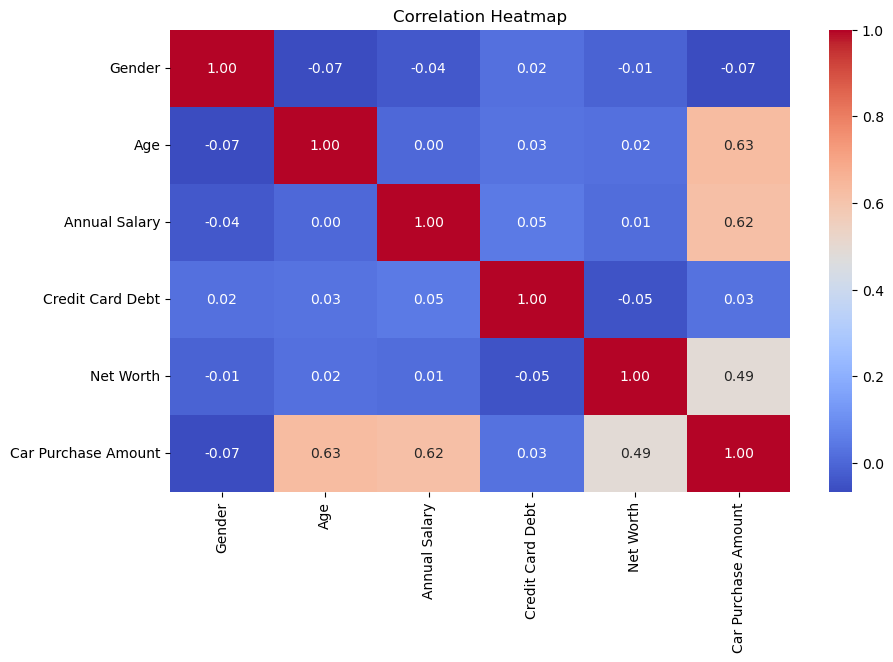1. Introduction
Predicting customer purchase behaviors is a crucial aspect of modern business intelligence. In this project, we aim to predict the car purchase amount of customers using a machine learning approach. By leveraging historical customer data, businesses like car dealerships can tailor their marketing strategies and better understand customer spending patterns.
The dataset used for this project includes detailed customer information such as age, income, credit card debt, and other financial metrics. Through this analysis, we not only aim to develop an accurate predictive model but also gain insights into the key factors influencing customer purchase behavior.
2. Dataset Overview
The dataset, Car_Purchasing_Data.csv, contains information on customers and their car purchase amounts. Below is an overview of the key features in the dataset:
Customer Name: Identifier for each customer.
Gender: Customer’s gender (categorical).
Age: Age of the customer in years.
Annual Salary: Customer’s annual income in dollars.
Credit Card Debt: Total credit card debt of the customer in dollars.
Net Worth: Customer’s net worth in dollars.
Car Purchase Amount: Target variable representing the amount spent on car purchases in dollars.
3. Exploratory Data Analysis (EDA)
Exploratory Data Analysis (EDA) is a critical step in any data science project, allowing us to understand the data’s structure, identify patterns, and uncover relationships among features. In this section, we’ll analyze the Car Purchasing Dataset to extract key insights before proceeding with data preparation and modeling.
Dataset Snapshot
We begin by loading the dataset and displaying its first few rows to understand its structure:
# Import necessary libraries
import pandas as pd
# Load the dataset
data = pd.read_csv('Car_Purchasing_Data.csv')
# Display the first 5 rows of the dataset
print(data.head())
Customer Name Customer e-mail Country \
0 Martina Avila cubilia.Curae.Phasellus@quisaccumsanconvallis.edu USA
1 Harlan Barnes eu.dolor@diam.co.uk USA
2 Naomi Rodriquez vulputate.mauris.sagittis@ametconsectetueradip... USA
3 Jade Cunningham malesuada@dignissim.com USA
4 Cedric Leach felis.ullamcorper.viverra@egetmollislectus.net USA
Gender Age Annual Salary Credit Card Debt Net Worth \
0 0 42 62812.09301 11609.380910 238961.2505
1 0 41 66646.89292 9572.957136 530973.9078
2 1 43 53798.55112 11160.355060 638467.1773
3 1 58 79370.03798 14426.164850 548599.0524
4 1 57 59729.15130 5358.712177 560304.0671
Car Purchase Amount
0 35321.45877
1 45115.52566
2 42925.70921
3 67422.36313
4 55915.46248
Descriptive Statistics
To summarize the central tendency, spread, and range of the dataset:
# Display descriptive statistics
print(data.describe())
Gender Age Annual Salary Credit Card Debt \
count 500.000000 500.000000 500.000000 500.000000
mean 0.506000 46.224000 62127.239608 9607.645049
std 0.500465 7.990339 11703.378228 3489.187973
min 0.000000 20.000000 20000.000000 100.000000
25% 0.000000 41.000000 54391.977195 7397.515792
50% 1.000000 46.000000 62915.497035 9655.035568
75% 1.000000 52.000000 70117.862005 11798.867487
max 1.000000 70.000000 100000.000000 20000.000000
Net Worth Car Purchase Amount
count 500.000000 500.000000
mean 431475.713625 44209.799218
std 173536.756340 10773.178744
min 20000.000000 9000.000000
25% 299824.195900 37629.896040
50% 426750.120650 43997.783390
75% 557324.478725 51254.709517
max 1000000.000000 80000.000000
The dataset contains customer information with features such as:
Customer Name: Name of the customer (e.g., “Martina Avila”).Customer e-mail: Email addresses, likely irrelevant for modeling.Country: All entries show “USA,” indicating no variability in this feature.Gender: Encoded as0(Male) and1(Female).Age: Ranges from 41 to 58 in the displayed rows.Annual Salary: Varies significantly, e.g., $53,798 to $79,370.Credit Card Debt: Amounts range from ~$5,358 to ~$14,426.Net Worth: Wide variability, e.g., $238,961 to $638,467.Car Purchase Amount: Target variable with values between ~$35,321 and ~$67,422.
Insights*:*
The dataset has a mix of demographic and financial features.
CountryandCustomer e-mailappear to add no predictive value.Financial metrics like
Annual Salary,Credit Card Debt, andNet Worthare likely key predictors of theCar Purchase Amount.
Feature Distributions
To understand how the numerical features are distributed:
import matplotlib.pyplot as plt
import seaborn as sns
# Plot histograms for numerical features
data[['Age', 'Annual Salary', 'Credit Card Debt', 'Net Worth', 'Car Purchase Amount']].hist(
figsize=(12, 8), bins=20, edgecolor='black')
plt.tight_layout()
plt.show()

This plot provides the following insights:
Age: The age distribution is approximately normal, with most customers aged between 40 and 50.Annual Salary: Salaries are normally distributed, peaking around $60,000 to $70,000.Credit Card Debt: Debt levels are normally distributed, centred near $10,000.Net Worth: Net worth is slightly right-skewed, with most values concentrated between $300,000 and $600,000.Car Purchase Amount: The target variable follows a roughly normal distribution, peaking around $40,000 to $50,000.
These distributions suggest balanced data for modelling, with no major irregularities or extreme skewness.
Correlation Analysis
To identify relationships between numerical features:
# Plot a correlation heatmap
plt.figure(figsize=(10, 6))
sns.heatmap(data.corr(), annot=True, cmap='coolwarm', fmt='.2f')
plt.title('Correlation Heatmap')
plt.show()
This correlation heatmap reveals the following insights:
AgeandAnnual Salaryboth have strong positive correlations withCarPurchase Amount(0.63 and 0.62, respectively), making them important predictors.Net Worthhas a moderate positive correlation withCar PurchaseAmount(0.49), suggesting it is also a relevant feature.Other features like
GenderandCredit Card Debthave very weak or negligible correlations withCar Purchase Amount, indicating they may contribute less to the prediction.
Overall, financial metrics and age are the most influential factors for predicting car purchase amounts.
Pair Plot
To visualize pairwise relationships:
# Generate a pair plot
sns.pairplot(data[['Age', 'Annual Salary', 'Credit Card Debt', 'Net Worth', 'Car Purchase Amount']])
plt.show()

This pair plot provides the following insights:
Age,Annual Salary, andNet Worthshow positive linear relationships withCar Purchase Amount, confirming their predictive relevance.Credit Card Debtdoes not show a clear relationship withCar Purchase Amount, indicating it may have less predictive value.Features like
Annual SalaryandNet Worthshow strong positive correlations with each other, which could lead to multicollinearity.All numerical features exhibit fairly normal distributions, suitable for regression modelling.
This visualization supports the importance of key financial metrics in predicting Car Purchase Amount.
4. Data Preparation and Feature Engineering
Before building the model, we need to clean and prepare the data to ensure it is suitable for training. This involves handling missing values, scaling numerical features, and selecting relevant features.
Handling Missing Values
We check for and address any missing values in the dataset:
# Check for missing values
print(data.isnull().sum())
Customer Name 0
Customer e-mail 0
Country 0
Gender 0
Age 0
Annual Salary 0
Credit Card Debt 0
Net Worth 0
Car Purchase Amount 0
dtype: int64
The dataset does not have missing values, so no further action is needed.
Feature Selection
We drop irrelevant columns that do not contribute to prediction, such as Customer Name, Customer e-mail, and Country.
# Drop irrelevant columns
data = data.drop(['Customer Name', 'Customer e-mail', 'Country'], axis=1)
Encoding Categorical Variables
The Gender column is already encoded as numerical values (0 for male, 1 for female), so no further encoding is required.
Scaling Numerical Features
To ensure all features are on the same scale, we use StandardScaler:
from sklearn.preprocessing import StandardScaler
# Separate features and target variable
X = data.drop('Car Purchase Amount', axis=1) # Features
y = data['Car Purchase Amount'] # Target variable
# Apply scaling
scaler = StandardScaler()
X_scaled = scaler.fit_transform(X)
Scaling is crucial because features like Net Worth and Credit Card Debt are on different scales, which could bias the model.
5. Model Building and Evaluation
To streamline the model selection and evaluation process, we will use an AutoML package to automatically train, evaluate, and fine-tune a range of regression models. This approach ensures that we identify the best-performing model without manually testing each algorithm.
Installing and Importing AutoML Package
We use the PyCaret library for AutoML. If it's not already installed, you can install it as follows:
pip install pycaret
Import the required modules:
from pycaret.regression import setup, compare_models, pull, save_model
Initializing the AutoML Environment
We initialize the AutoML pipeline using setup() to specify the dataset, target variable, and configuration options:
# Initialize PyCaret regression setup
automl = setup(
data=data,
target='Car Purchase Amount', # Target variable
train_size=0.8, # Train-test split ratio
session_id=42, # For reproducibility
normalize=True # Ensures feature scaling
)
Key Parameters:
data: The dataset.target: The column to predict (Car Purchase Amount).normalize: Automatically scales numerical features for better model performance.
Training and Selecting the Best Model
We use compare_models() to test multiple regression models and select the best one based on performance metrics such as Mean Absolute Error (MAE):
# Compare models and select the best one
best_model = compare_models(sort='MAE')
The compare_models() function evaluates a range of regression models, such as:
Linear Regression
Ridge Regression
Random Forest
Gradient Boosting
Neural Networks
It ranks models based on the chosen metric (MAE in this case).
Viewing Model Results
We can view the detailed results of all tested models using the pull() function:
# Display comparison results
results = pull()
print(results)
Model MAE MSE \
par Passive Aggressive Regressor 208.0755 5.976193e+04
br Bayesian Ridge 208.7050 5.860764e+04
lar Least Angle Regression 208.7060 5.860718e+04
lr Linear Regression 208.7063 5.860726e+04
huber Huber Regressor 208.7345 5.924132e+04
llar Lasso Least Angle Regression 208.7610 5.862013e+04
lasso Lasso Regression 208.7614 5.862036e+04
ridge Ridge Regression 208.7838 5.955234e+04
catboost CatBoost Regressor 759.9736 2.431932e+06
et Extra Trees Regressor 1230.1609 4.432660e+06
gbr Gradient Boosting Regressor 1353.6206 3.992229e+06
lightgbm Light Gradient Boosting Machine 1385.5471 4.846046e+06
xgboost Extreme Gradient Boosting 1585.8605 5.859166e+06
rf Random Forest Regressor 1796.2792 7.348954e+06
knn K Neighbors Regressor 2748.0798 1.436356e+07
en Elastic Net 2833.3671 1.310012e+07
ada AdaBoost Regressor 3169.2546 1.869494e+07
dt Decision Tree Regressor 3244.9663 1.971123e+07
omp Orthogonal Matching Pursuit 7118.7649 7.960319e+07
dummy Dummy Regressor 8492.6023 1.179679e+08
RMSE R2 RMSLE MAPE TT (Sec)
par 243.5812 0.9994 0.0062 0.0051 0.012
br 241.3427 0.9995 0.0062 0.0051 0.006
lar 241.3415 0.9995 0.0062 0.0051 0.007
lr 241.3417 0.9995 0.0062 0.0051 0.814
huber 242.6528 0.9994 0.0062 0.0051 0.007
llar 241.3800 0.9995 0.0062 0.0051 0.008
lasso 241.3805 0.9995 0.0062 0.0051 0.521
ridge 243.3959 0.9994 0.0062 0.0051 0.013
catboost 1441.0213 0.9804 0.0507 0.0242 0.457
et 2023.9017 0.9626 0.0712 0.0383 0.023
gbr 1970.8825 0.9653 0.0648 0.0381 0.016
lightgbm 2127.9460 0.9589 0.0710 0.0408 0.047
xgboost 2253.0673 0.8504 0.0743 0.0458 0.154
rf 2638.4407 0.9382 0.0855 0.0523 0.027
knn 3759.1558 0.8749 0.1130 0.0766 0.011
en 3599.7438 0.8860 0.1072 0.0776 0.006
ada 4277.6572 0.8386 0.1275 0.0887 0.020
dt 4358.9889 0.8303 0.1271 0.0861 0.007
omp 8896.6669 0.2925 0.2295 0.1892 0.007
dummy 10809.2149 -0.0295 0.2766 0.2327 0.006
This result summarizes the performance of various regression models tested using an AutoML package. Key observations:
Top Performers:
Passive Aggressive Regressor,Bayesian Ridge,Least Angle Regression, andLinear Regressionhave the lowest MAE (~208) and RMSE (~241), with the highest R² (~0.9995), making them the most suitable models for this dataset.Underperformers:
Dummy RegressorandOrthogonal Matching Pursuitperformed poorly, with very high MAE (>7,000) and negative/low R² values, indicating they fail to explain the variance in the data.Tree-Based Models: Models like
CatBoost Regressor,Extra Trees Regressor, andGradient Boosting Regressorshowed decent performance (R² ~0.96–0.98) but significantly higher errors (MAE > 750), making them less competitive.Neural Networks and Ensembles: Models like
LightGBMandAdaBoost Regressorhave moderate R² (0.83–0.96) but considerably higher MAE and RMSE.Efficiency: Top-performing models (e.g.,
Bayesian Ridge,Linear Regression) trained quickly (<1 second), making them both effective and computationally efficient.
For this dataset, Passive Aggressive Regressor*,* Bayesian Ridge*, and* Linear Regression are the top-performing models. They exhibit:
High Accuracy*: Low MAE (~208) and RMSE (~241), with R² values close to 1.*
Efficiency*: Very fast training times (all under 1 second).*
Simplicity*: These models do not require complex feature engineering or additional computation, making them practical for deployment.*
While more complex models (e.g., CatBoost, Gradient Boosting) also perform well, their higher error rates and computational cost make them less suitable for this project. The Passive Aggressive Regressor should be included as a strong candidate.
7. Deployment with Streamlit
To make the trained model accessible for real-world use, we will deploy it using Streamlit, a Python framework for building interactive web apps. Based on our evaluation, the Passive Aggressive Regressor was selected as the best model for deployment due to its high accuracy, low error, and fast training time. The deployment process involves saving this trained model using joblib, creating a Streamlit app, and enabling users to input data and receive predictions.
Step 1: Save the Trained Model
We use joblib to save the best-performing model for later use in the Streamlit app:
# Save the scaler
joblib.dump(scaler, 'scaler.pkl')
print("Scaler saved as 'scaler.pkl'")
# Save the trained model
joblib.dump(best_model, 'car_purchase_model.pkl')
print("Model saved as 'car_purchase_model.pkl'")
Scaler saved as 'scaler.pkl'
Model saved as 'car_purchase_model.pkl'
Step 2: Create the Streamlit App
We create an app.py file to build the interactive app:
import streamlit as st
import joblib
import numpy as np
from sklearn.preprocessing import StandardScaler
# Load the saved model and scaler
model = joblib.load('car_purchase_model.pkl')
scaler = joblib.load('scaler.pkl') # Save and load the scaler used during training
# Define the app interface
st.title("Car Purchase Amount Prediction")
st.write("Enter customer details below to predict their car purchase amount.")
# Input fields for user data
age = st.number_input("Age", min_value=18, max_value=100, step=1, value=30)
annual_salary = st.number_input("Annual Salary ($)", min_value=0.0, step=1000.0, value=50000.0)
credit_card_debt = st.number_input("Credit Card Debt ($)", min_value=0.0, step=100.0, value=5000.0)
net_worth = st.number_input("Net Worth ($)", min_value=0.0, step=1000.0, value=100000.0)
gender = st.selectbox("Gender", options=["Male", "Female"])
# Encode gender as numerical value
gender_encoded = 0 if gender == "Male" else 1
# Predict button
if st.button("Predict"):
# Prepare input data as a NumPy array
input_data = np.array([[gender_encoded, age, annual_salary, credit_card_debt, net_worth]])
# Apply the same scaling as during training
input_data_scaled = scaler.transform(input_data)
# Make prediction
prediction = model.predict(input_data_scaled)
# Display the result
st.success(f"Predicted Car Purchase Amount: ${prediction[0]:,.2f}")
Step 3: Run the Streamlit App
To run the app locally, use the following command in your terminal:
Build a simple Streamlit app for practical model deployment.
streamlit run streamlit_app.py
Step 4: Generate a requirements.txt file
The requirements.txt file is essential for the model to be deployed on Streamlit Cloud, it will tell which modules need to be imported to run the model:
streamlit
joblib
numpy
pandas
scikit-learn
Step 5: Deploy the Streamlit App on the Streamlit Cloud Community (optional)
You can click on the Deploy button on the top right of the app interface (after pushing the repo to Github), and then the app will be deployed after a few seconds.

The result will look like this:
https://minhhoang2606-car-price-prediction-by-machine-learni-app-65yvev.streamlit.app/
8. Conclusion
In this project, we developed a machine learning model to predict Car Purchase Amounts based on customer demographic and financial data. The Passive Aggressive Regressor was selected as the best-performing model due to its high accuracy, low error, and fast training time. Using Streamlit, we deployed the model to create an interactive app that allows users to input customer details and receive real-time purchase predictions.
Through this process, we demonstrated the importance of:
Exploratory Data Analysis: Understanding data distributions and relationships to identify meaningful patterns.
Automated Model Selection: Leveraging tools like AutoML to efficiently compare and optimize models.
Deployment: Making machine learning solutions accessible to end-users through simple and intuitive interfaces.
This project highlights how machine learning can empower businesses by providing actionable insights, improving decision-making, and enhancing customer experiences. The deployed app can be further extended for real-world use, such as integrating additional features, handling larger datasets, or deploying on cloud platforms for scalability.
Appendices
Code: https://github.com/Minhhoang2606/Car-Purchase-Amount-Predictions-Using-Machine-Learning
Data source: https://www.kaggle.com/datasets/dev0914sharma/car-purchasing-model?select=Car_Purchasing_Data.csv

